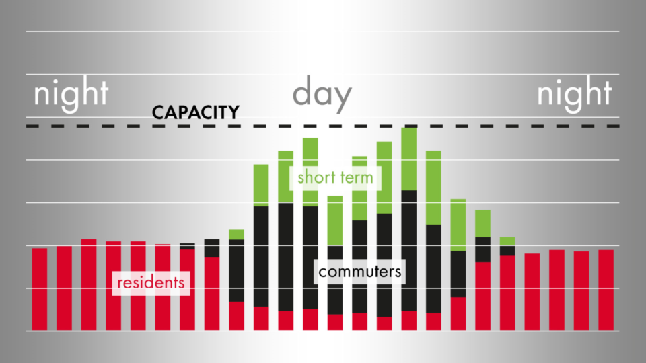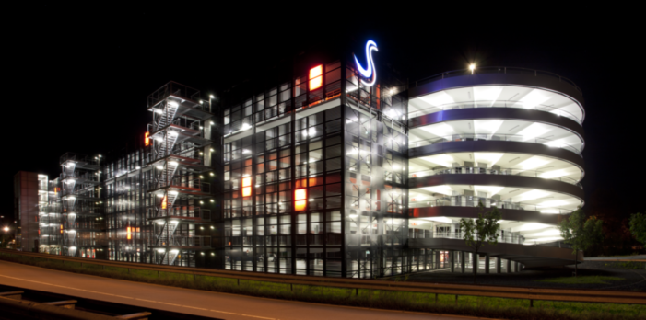Parking Capacity Calculation

Smart data fosters smart developments
Are you planning a new shopping centre with apartments, a hotel with leisure facilities?Do you need to provide a minimum number of parking spaces to obtain planning permission? How can you know how many parking spaces will be needed?
Will these parking spaces be occupied 24/7? Probably not, but what is the maximum number of parked cars you should plan for? Is there a municipal parking space norm depending on a range of metrics?
What if you had the statistical evidence that practically demonstrates that the municipal standard number of parking spaces will never be anywhere near 85% occupied? Even during peak moments! Q-Park has that information and knows how to apply it to a variety of situations.
How many cars do you really need to park?
In the parking industry, we all know that constructing parking spaces underground is expensive. It is therefore important to understand the parking capacity requirements of a development or building early on in the design phase. This insight enables the project developer to dimension for the parking capacity required.
Ideally, we at Q-Park like to be involved in a development project as early as possible so we can assist our partners and analyse alternative solutions together. Considering multiple scenarios for construction often presents opportunities that would otherwise not be revealed. Questions we ask in this phase include:
What do project developers want from their investments, and how quickly?
What do landlords expect from their tenants?
What facilities do municipalities want to provide for their residents, commuters, businesses and visitors?
Can other functions be added to make the project viable?
Using our current and historic occupancy data, our KPI benchmarks and a wide range of reference projects, we support public and private landlords and real estate project developers to:
reduce construction time & costs
maximise end-use comfort and convenience
improve urban liveability
enhance the attractiveness of the surroundings.
Capacity calculation service
Q-Park aims to calculate parking capacity and parking fees so that there are always enough spaces available. Capacity optimisation helps developers to calculate the number of parking spaces required more accurately.
As part of our capacity calculation service we:
calculate parking requirements and where appropriate we challenge the municipal norm with solid and highly respected data
ensure that the development will not have excessive over-capacity
reduce overall development costs by only building as many parking spaces as will actually be used.
Providing value for project developers
Our experience and expertise add value to the whole project. We advise on efficient parking capacity.
Our advice is based on our experience, our real-time data and on decades of data from thousands of parking facilities all over West Europe, servicing all kinds of parking needs in a wide range of urban situations.
It’s our business to operate a parking facility to be cost effective and it’s also our business to have the capability to analyse data, detect architypes and to mirror these onto new projects.
Parking facility capacity is often based on adding municipality standards per function:
spaces for residents,
spaces for commuters,
spaces for short term visitors such as shoppers.

We know from our data that it’s not necessary to simply add these numbers together. After all, as residents leave for work, the commuters arrive for the day, so the required capacity calculation looks something like this:

Involve the parking experts early
Make use of the Q-Park’s parking facility planning expertise at an early stage in the project development. Allow the parking capacity experts to advise on the numbers of parking spaces required before the architectural planning and approval phase.
Q-Park is aware that the fewer parking spaces you have to build, the lower the investment, the easier it is to finance the project, the shorter the construction time and the sooner your development will start to earn money.
Q-Park doesn’t look at the asset development in isolation, we look at the balance and norms for the area together with the balance of mobility concepts, public transport as well as parking needs. Alternative parking solutions in the vicinity may also meet the demand. The infrastructure of the entire area will be put together like a jigsaw puzzle.
The whole development, not just parking

Infrastructural routing is crucial, as is the routing within the parking facility. Good infra design is hardly ever more expensive; bad design always is. And there is something else to remember when dimensioning a parking facility: more parking spaces does not equal more revenue.
We have multiple reference projects which have a better return on investment compared to the original plan due to the incorporation of our expertise. For public sector landlords, a more accurate capacity calculation means that less public money is required to finance constructing the parking facilities needed to serve the public needs in urban areas.
Scaling up is a viable option
From our experience and car park occupancy data (big data) we know that mixing functions and scaling up in the vicinity of a parking facility works. An unattractive development project for a shopping centre car park can suddenly become viable when leisure amenities used outside shopping hours are added to the project. For example, shoppers and day trippers want to park between 10 and 4 while those visiting the gym, cinema or eating out will want to park from 6 p.m. onwards. Different functions mean different parking behaviour.
Our aim is to calculate the capacity and parking fees of parking facilities so that there are always enough parking spaces available (maximum occupancy 85−95%). Capacity optimisation helps developers to calculate the number of parking spaces required more accurately, while enabling owners of existing property to better utilise their parking spaces.
Get in touch
There's an element of forecasting in car parking capacity calculations. And we also know that not every project behaves as expected. However, we do have masses of historical data on car park occupancy that we use to feed our models and we are more than happy to share our insights to help you get the parking capacity calculation right the first time.

Forecasting car parking capacity needs, based on historical data
Case studies
Plein 1992 – Maastricht
Plein 1992, named after the European Union Treaty, was developed in the late 1990s. It has a mix of functions including offices, shops and cultural amenities. The square ‘weaves different functions together’.
The estimate for the number of parking spaces required to meet the needs of the area were entered into the Q-Park functional calculation model that Q-Park has developed and refined over the years.
Using the model, which includes parking customer profiling and international benchmarking, it became apparent that due to the varying visiting patterns of different target groups the actual number of parking spaces needed to provide sufficient parking capacity (including safety margins) could be reduced by more than 35%.
This meant that a smaller parking facility could be built and there would still be sufficient parking capacity, which resulted in lower construction and operational costs.

Cars underground, residents, commuters and visitors above ground
Flexible construction at Spaarne Hospital
Sometimes being flexible means that we build flexibly too. The parking facility at Spaarne Hospital is an excellent example. Two additional parking decks were added a few years after the parking facility was first opened and the area around the hospital was fully developed. See our Spaarne Hospital showcase.

Original car park

Two more parking decks added later
There's an element of forecasting in car parking capacity calculations. Q-Park has masses of historical data on car park occupancy to feed capacity calculation models. We are more than happy to share our insights to help you get the parking capacity calculation right the first time.
